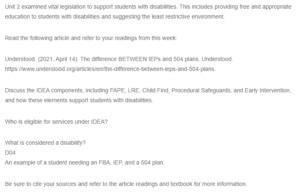Legislation Supporting Students with Disabilities-IDEIA, IEP, and 504 Plans
IDEA is a state regulation protecting learners with learning and additional disabilities. One of the IDEA’s components is FAPE, which is a dominant lawful right for disabled children. The right necessitates schools to offer special eradication to meet the children’s exceptional necessities. Another component is LRE, which typically means that children needing special education should belong to the same class as other children to a feasible extent. Typically, IDEA places intense stress on guaranteeing the placement of the learners in the least restrictive environment (Saleh Matthew, n.d).
Further, in the Child Find component, the public schools must search, find, and assess children necessitating special edification. Procedural Safeguards are also among the IDEA components, and these are safeguards that IDEA forms to assist parents and disabled learners in implementing their rights under state regulation. Finally, the Early Intervention component addresses support and services for young kids and babies with disabilities.
IDEA Eligibility
Under IDEA, not all children are qualified for special education, and being diagnosed does not ensure eligibility (Lee, 2022). The IDEA provides categories under which kids must fall for them to be eligible. Some categories comprise deaf-blindness, emotional disturbance, deafness, and autism. Nevertheless, even after having the stated disabilities, the learners ought to have a disability as well as an outcome of the incapacity. Additionally, they must require special instruction to make progress in school.
What Is Considered a Disability
Kids are assessed as per §§300.304 through 300.311, and having a disability means having a visual impairment, a language or speech deficiency, a hearing deficiency, and an intellectual impairment.
An Example of a Student Needing an FBA, IEP, and a 504 Plan
An example of a learner requiring an FBA is one with behavior challenges like acting up. Additionally, a learner with autism, emotional disorder, learning disability, or physical disability is eligible for IEP. In the 504 plan, a learner with type 1 diabetes may need it.
References
Lee Andrew M.I. (2022). Individuals with Disabilities Education Act (IDEA). Understood – For learning and thinking differences. https://www.understood.org/en/articles/individuals-with-disabilities-education-act-idea-what-you-need-to-know
Saleh Matthew. (n.d.). Your Child’s Rights: 6 Principles of IDEA. Smart kids with learning disabilities. https://www.smartkidswithld.org/getting-help/know-your-childs-rights/your-childs-rights-6-principles-of-idea/
ORDER A PLAGIARISM-FREE PAPER HERE
We’ll write everything from scratch
Question 
Unit 2 examined vital legislation to support students with disabilities. This includes providing free and appropriate education to students with disabilities and suggesting the least restrictive environment.

Legislation Supporting Students with Disabilities-IDEIA, IEP, and 504 Plans
Read the following article and refer to your readings from this week:
Understood. (2021, April 14). The difference BETWEEN IEPs and 504 plans. Understood. https://www.understood.org/articles/en/the-difference-between-ieps-and-504-plans.
Discuss the IDEA components, including FAPE, LRE, Child Find, Procedural Safeguards, and Early Intervention, and how these elements support students with disabilities.
Who is eligible for services under IDEA?
What is considered a disability?
D04
An example of a student needing an FBA, IEP, and a 504 plan.
Be sure to cite your sources and refer to the article readings and textbook for more information.